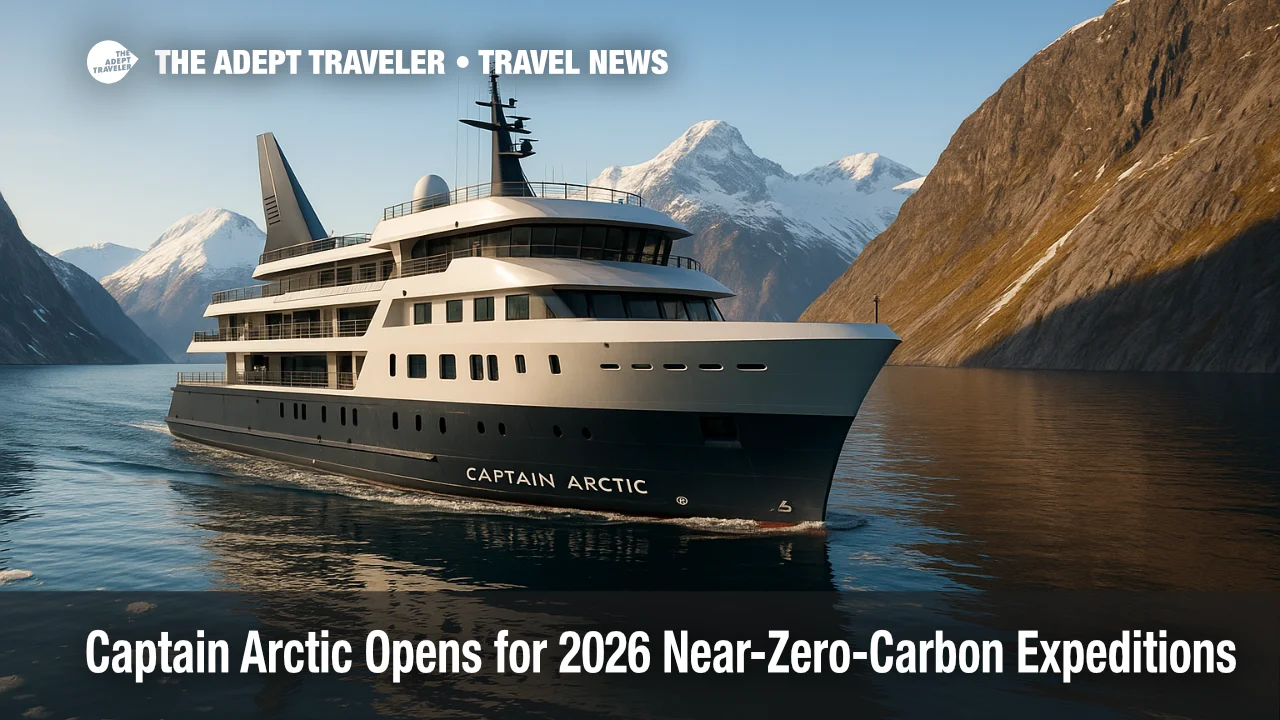Captain Arctic Opens Booking for 2026 Near-Zero-Carbon Expeditions

Minimal Impact Cruises has opened early bookings for its groundbreaking Captain Arctic, a 36-guest expedition ship that sails on solar power, wind energy, and electric propulsion. The vessel will debut in November 2026 with winter voyages along Northern Norway's fjords, followed by summer 2027 departures in Svalbard and early-autumn journeys to East Greenland. Purpose-built for fragile polar waters, Captain Arctic combines near-silent navigation, zero-waste operations, and refined Nordic hospitality, offering travelers a chance to explore the High North responsibly while enjoying saunas, a panoramic lounge, and chef-led regional cuisine. Advance reservations secure preferred cabins and dates for these limited departures.
Key Points
- Why it matters: First near-zero-carbon expedition ship now open for booking
- Only 36 guests per voyage for low-impact exploration
- Solar sails, electric propulsion, and zero-waste systems slash emissions
- Launch season: Northern Norway, November 2026 through March 2027
- Svalbard summer sailings and East Greenland autumn voyages follow in 2027
- Six PTGA-certified guides lead daily hikes and kayak outings
Snapshot
Captain Arctic represents a decisive step toward decarbonizing polar cruising. Rigid solar-panel sails feed battery banks that power electric pods, allowing the ship to glide without vibration and with 90 percent fewer emissions than conventional diesel craft. Waste heat warms interior spaces, desalination produces fresh water onboard, and strict refuse protocols eliminate landfill output. Guests unplug-there is no Wi-Fi-while enjoying a Nordic sauna, cold-plunge bath, and quiet library. An open-bridge policy encourages conversation with the crew, fostering a deeper understanding of navigation and environmental stewardship. With early-bird fares now available, sustainability-minded travelers can secure a berth on what may become the model for future Arctic exploration.
Background
Interest in the Arctic has surged amid rising temperatures and lengthening tourist seasons, yet increased traffic threatens delicate ecosystems. Industry pioneers such as Hurtigruten and Ponant have already introduced hybrid or battery-assisted ships, but Captain Arctic pushes the envelope further by combining solar, wind, and biofuel backup power in a vessel designed from keel to mast for minimum impact. Built by French start-up Selar and operated by Minimal Impact Cruises-an offshoot of Polar Tracks Expeditions-the 230-foot ship carries 24 crew and six Polar Tourism Guides Association-accredited naturalists. Design priority went to hull efficiency, waste heat recovery, and silent running, enabling close wildlife encounters without disturbance. The project aligns with tightening IMO emission caps that will soon restrict heavy-fuel traffic in the region.
Latest Developments
Bookings Open for Northern Norway Launch Season
Sailing from Tromsø, the inaugural series runs November 2026 through March 2027. Guests will navigate ice-rimmed fjords beneath the aurora borealis; each seven-night itinerary balances shore hikes to Sami cultural sites with Zodiac forays among orcas and humpbacks. Silent propulsion allows closer whale approaches than engine-driven ships, while dark-sky protocols enhance Northern Lights viewing. Early reservations capture limited observation-suite cabins overlooking the bow.
Summer 2027 Svalbard Double Departure
Two 10-night voyages in June and July 2027 chart an anti-clockwise loop around Spitsbergen, seeking polar bears along melting pack ice and walrus haul-outs on Prins Karls Forland. Midnight-sun conditions extend outdoor time; guides lead photography walks and glaciology talks. Onboard menus highlight Arctic char and foraged cloudberries, all sourced within 250 miles to reduce food-mile emissions.
East Greenland Immersion, September 2027
A single 12-night expedition explores Sermilik Fjord and Scoresby Sound, the planet's largest fjord network. Captain Arctic's maneuverability lets it thread iceberg-choked passages where larger ships cannot venture. Guests may kayak beside calving glaciers or trek to Inuit archaeological sites. The journey concludes in Reykjavík, giving travelers a carbon-offset flight option via Iceland's growing sustainable-aviation-fuel program.
Analysis
Captain Arctic's small scale and technology stack arrive at a pivotal moment for expedition cruising. The sector grew 40 percent between 2016 and 2023, raising regulatory and ethical concerns about soot, noise, and overtourism. While hybrid engines have become common, few operators have married multiple renewable systems with a comprehensive waste-elimination strategy. Captain Arctic's solar sails deliver up to two megawatts under peak summer sun; combined with wind assistance, they cut generator use so drastically that hotel services rely largely on battery power. The absence of diesel vibration not only spares marine mammals but also redefines onboard luxury-silence, clean air, and uninterrupted vistas replace crowded lounges and constant engine hum.
Economically, the 36-guest model commands premium pricing yet minimizes fixed costs, making profitability feasible without mass-market volume. It also aligns with a consumer shift toward conservation-minded travel, particularly among Gen Z and millennial segments willing to pay for lower footprints. Competitors will watch closely: if Captain Arctic maintains schedule reliability in severe winter conditions, similar sail-and-battery hybrids could proliferate. The biggest hurdle remains supply-chain limitations for large-scale lithium batteries and the still-nascent availability of green fuels in high latitudes. Nonetheless, the project demonstrates that expedition cruising can pivot from incremental improvement to transformative design when operators place ecology at the core of brand identity.
Final Thoughts
Minimal Impact Cruises positions Captain Arctic as more than a ship-it is a statement that polar exploration can evolve from extractive adventure to regenerative experience. By restricting guest numbers, sourcing local provisions, and powering itineraries with sun and wind, the line offers travelers both access and accountability. Early bookings are likely to fill quickly, not merely because berths are scarce, but because demand for purpose-driven voyages is growing. Those who secure a cabin today will help chart a cleaner course for tomorrow's Arctic tourism, proving that discovery and preservation can share the same horizon aboard Captain Arctic.
